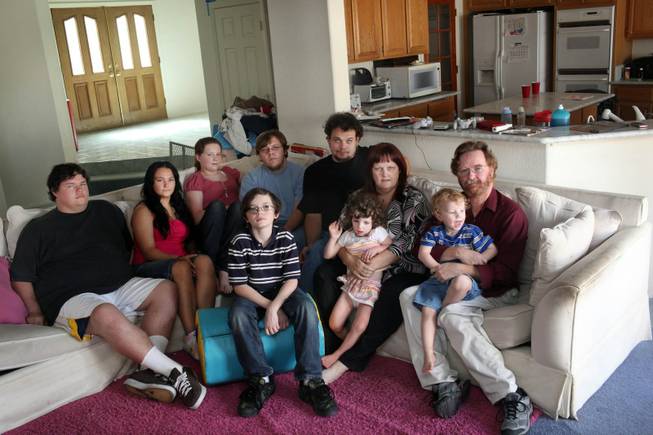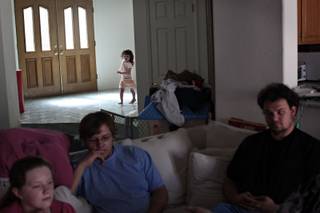
The Reynolds family, from left, Shawn, 20, Lacey, 18, Becky, 12, Steven, 20, Scott, 23, their mother, Christine with Mallory, 4, and their father, Russ, with Justin, 3, and Jake, 12, in front, pose in their Las Vegas home on Thursday, June 18, 2009.
Sunday, June 21, 2009 | 2 a.m.
Audio Clip
- Christine Reynolds talks about help from Clark Count Social Service and how there is no "emergency Medicaid."
-
Audio Clip
- Russ Reynolds talks about his wife, Christine, finding out she has breast cancer.
-
Audio Clip
- Russ and Christine Reynolds talk about what Clark County Social Service paid and didn't pay for.
-
Audio Clip
- Christine Reynolds on not putting daughter Mallory in a facility by herself.
-
Audio Clip
- Christine Reynolds talks about homeless shelters.
-
Sun Coverage
The homeless shelter is as near as next month’s rent for Christine Reynolds, who has enough money to clear one more payment and after that — no clue.
Her breast cancer complicates things. So do her eight children — particularly 4-year-old Mallory, who has a chromosomal condition called Turner syndrome.
The rest of the family — the parents, the other kids, ages 3 through 23 — could live in the family cars if they have to. They could live in any shelter able to house a big family if they have to. But Mallory has a heart condition and environmental allergies, and she needs frequent medication and someone to watch her sleep, in case the seizures start. Mallory has migraines too. She screams through them, and they last for hours.
Mallory, who was never supposed to see outside the of the infant intensive care unit, needs her home and needs her family around her, which means they all need to stay in their house, Reynolds says.
They have no way of doing it.
“Everything pulled out from under us,” Reynolds says.
“I never expected this.”
Like many middle-class families facing homelessness, the Reynoldses were hit with problems that came at them quickly, one after another. The family moved to Las Vegas from California just over a year ago. The three eldest children received grants to attend UNLV and switching states was cheaper than paying for dorms. Besides, the family wanted to stay together.
In November, Christine was diagnosed. She doesn’t have health insurance. Nobody in the family has health insurance, in fact, except for Mallory, who is on Medicaid.
Despite this, Christine and her husband, Russ, say they’ve had to pay tens of thousands of dollars for Mallory’s health care — huge bills that racked up and weren’t always paid on time, destroying their credit.
In Nevada, they found a rent-to-own home big enough to fit the 10-person family. Their rent is $3,000, and their other monthly expenses total about $2,000. This wasn’t a problem until Russ’ job, finding actors extra work in Hollywood, took a hit after the writers strike slowed or stopped production on movies and TV shows. And Christine, who had worked with her husband, wrangling extras on studio sets, was no longer able to help because of her illness.
Russ’ business is starting to come back, but not fast enough. So now the family is stuck between a rock and their rent. Christine figures if the family can just somehow come up with enough money to stay in the home for three more months, they will be through the rough patch and on the rebound.
“We just need a bit of help here,” Christine said. “Not a lot. Just a little. A loan. Something to keep us afloat.”
Her last chemotherapy treatment was Friday. Maybe now her hair and eyebrows will come back. Or maybe the cancer will come back. The first time surgeons went in, they didn’t get it all. So they went in again, and scraped out more. Her treatment is being paid for with a grant from the Southern Nevada affiliate of Susan G. Komen For the Cure, all but around $25,000 of it — surgery costs.
Could the family cram into an apartment? Sure, if they had the money. And even then, they’re worried that Mallory’s medical condition, her seizures and fits and screaming migraines, might get them kicked out when neighbors have had enough.
Could the older children quit school for jobs? They’re thinking about it, but they don’t have cars and don’t know, even if they could find work, whether those jobs would bring in enough to keep the family afloat. In July, the older boys are leaving to work summer jobs in California — setting up equipment at county fairs and doing odd jobs on the midway.
Is there a foundation, or a person, who could give them a loan just to get through the next few months? Christine has sent out dozens of letters begging for help.
This is embarrassing. This makes her feel like a bad mother.
“We’ve got to find a place where we’re not going to lose Mallory,” she says. “We were told so many times that we would, and we’re not going to.”
Homeless families make up more than 30 percent of the total homeless population, according to the National Center on Family Homelessness — an organization that ranked Nevada one of the worst states in the country for homeless children.
Although cancer can throw a family’s finances into tailspin at any time, the economy has added an palpable strain, said Stacey Gross, Community Programs Manager for Komen’s Southern Nevada affiliate.
“It’s definitely worse now than ever before,” she said.
Christine Reynolds can attest to that. She “never saw this coming.”


Join the Discussion:
Check this out for a full explanation of our conversion to the LiveFyre commenting system and instructions on how to sign up for an account.
Full comments policy